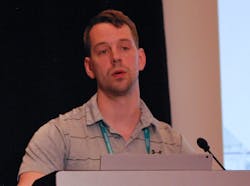Midwestern utility puts wireless vibration monitoring into play
For Evergy, an electric utility provider operating in eastern Kansas and western Missouri, the challenges were all too familiar. Like many utilities, the company was facing pressure to reduce its capital expenditure while maintaining the high level of reliability it has always provided. It was also facing the changing energy market that drove a need for more flexibility in utilizing high- and low-load capacity when needed. Therefore, operational efficiency was paramount.
“We are always striving to reduce downtime and to move away from time-based activities and toward condition-based maintenance,” Gabe Stanton, senior manager of monitoring and diagnostics at Evergy, told the audience gathered at a session during Emerson Exchange. He also pointed out that the company wanted to identify equipment issues early enough that it had an accurate backlog so it could properly plan and schedule maintenance.
When dealing with electrical needs for customers, reliability of equipment and workforce can’t be compromised.
When it came time to address vibration monitoring in its fossil-generation sites, Evergy teamed with Emerson on a new project that seeks to install approximately 5,000 wireless sensors in all of its fossil sites by the end of the year. It is all part of a plan to build a monitoring and diagnostic center that started in 2018.
One of those technologies was vibration monitoring, which is the subject Stanton, his team and representative from Emerson were on hand to discuss.
Kevin Ross, Emerson’s account manager, process systems and reliability, said the project was a “very large deployment” and the goal was to get to a 100% automated monitoring system in Evergy’s plants. Utilizing Emerson’s AMS Wireless Vibration Monitor, which was released two years ago and has seen more than 40,000 units placed into field operations, the project swiftly moved Evergy from a time-based monitoring operation to a condition-based one.
With time-based monitoring some assets only get checked every 60 to 90 days, Ross said. With the automated monitoring system, “you’re really changing your work practices and letting the sensors tell you where the work is going to be needed that day,” he said.
The system installed is wireless. Drew Mackley, director of sales enablement, reliability solutions, at Emerson, said the company has been in the wireless vibration-monitoring business since 2000. He added that two decades of experience allowed the company to debut the third-generation AMS wireless vibration monitor in 2020. The unit is able to connect to existing WirelessHART networks and deliver data frequently. It can also help keep personnel out of production areas where safety concerns exist.
Managing human workloads and creating efficiency are benefits Evergy saw from the new system. Stanton said vibration technicians at the utility have gone from supporting two to four plants to supporting the entire fleet for troubleshooting.
On the costs side, the vibration-monitoring project has led to approximately $150,000 in risk avoidance from vibration calls when data was used from previous sensors.
Stanton reiterated that throughout the installation there were lessons to be learned. “You’re not going to do a project of this size across an entire power-generation fleet and have everything go smoothly,” he said.
One setback was the process of getting hazardous-area certification in the sensors that delayed the project about a year. Emerson worked with its team and was able to get the certification. “It actually wasn’t such as bad thing as it gave us some padding in our timeline to get caught up with everything we had in flight,” Stanton said.
Stanton said, at the time the monitoring project was started, Evergy was also implementing other big data projects. “We learned very quickly that we needed to have a good data governance process, especially as we were standardizing how we were doing things across the enterprise,” he said. “We needed to be as consistent as possible.”
In the end, Evergy was able to build the condition-monitoring system it set out to implement while maintaining its reliability.
Get the best of Emerson Exchange Americas 2022
When the event comes to a close, the best, most important coverage will be compiled into a report. Register now to pre-order the report and be among the first to receive it in your inbox.
About the Author

Leaders relevant to this article:


